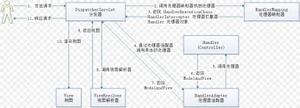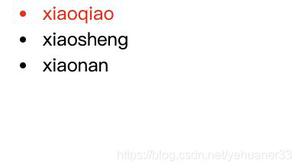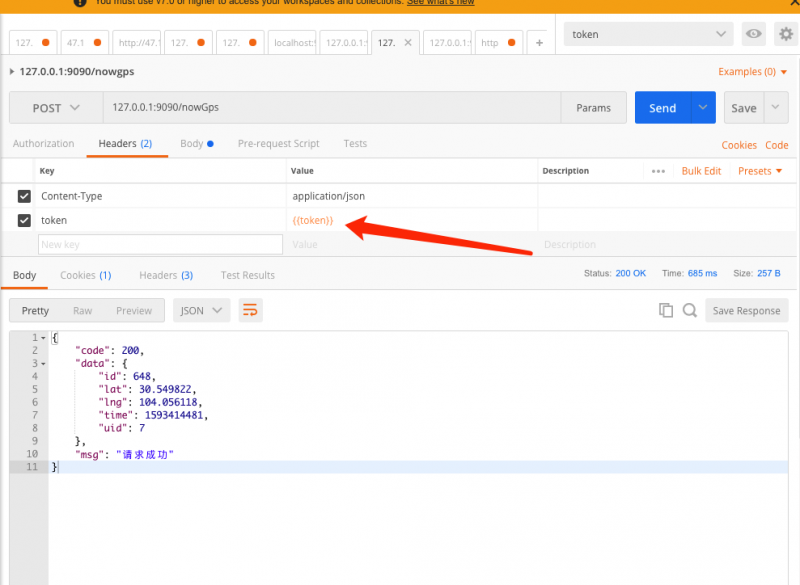GPS定位系统(四)——Vue前端
前言
GPS系列——Vue前端,github项目地址
前面已经学习了Android、Java端的代码实现,现在开始介绍网站vue" title="前端vue">前端vue的管理框架。
文中也会有大量代码,对于admin管理框架,我是模仿iview-amin,然后新建一个项目,手敲下来的,只取了自己所需的模块,目的就是为了练手,期间也遇到了很多问题,建议大家也可以自己模仿者手敲一遍。也可以使用elementUI,这个框架整体而言比iview更好一些。
GPS定位系统系列
GPS定位系统(一)——介绍
GPS定位系统(二)——Android端
GPS定位系统(三)——Java后端
GPS定位系统(四)——Vue前端
GPS定位系统(五)——Docker
- Docker nginx 二级域名无端口访问多个web项目
- Docker nginx https二级域名无端口访问多个web项目
- 持续部署——Travis+Docker+阿里云容器镜像
收获
学习完这篇文章你将收获:
- Vue + Vue-cli + iview + axios + vue-router + vuex 的实践
- 高德地图 js api的使用
- axios restful接口的异常处理封装
- 上传头像
- modal弹框编辑个人信息template
- admin管理框架
[TOC]
正题
一、admin框架介绍

框架搭建了整体架构,单页面的web应用。通用缩放式菜单栏,选项卡式管理网页、面包屑导航、bug日志管理、全屏等功能。
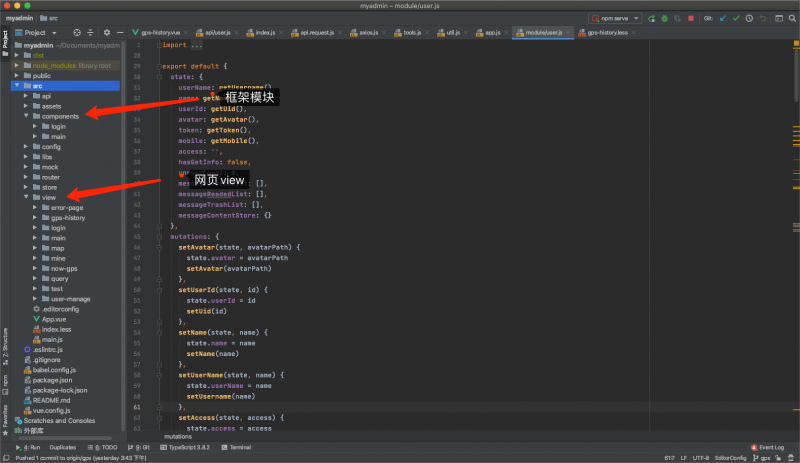
框架使用了通用热门的 VUE一套框架,包括Vue + Vue-cli + vuex + vue-router+iview,具体还请参见源码。
单页面大致结构
<template><Layout class="main">
<Sider ref="sider" class="sider" hide-trigger collapsible :collapsed-width="78" v-model="isCollapsed">
<div class="logo-con">
<img v-show="!isCollapsed" :src="https://juejin.im/post/5f114f21e51d45347c1b8fca/maxLogo" class="max-logo" key="max-logo"/>
<img v-show="isCollapsed" :src="https://juejin.im/post/5f114f21e51d45347c1b8fca/minLogo" class="min-logo" key="min-logo"/>
</div>
<!-- 展开状态-->
<Menu class="open-menu" ref="menu" :active-name="$route.name" :open-names="openedNames" theme="dark" width="auto"
v-show="!isCollapsed"
@on-select="turnToPage">
<template v-for="item in menuList">
<!-- 有children且只有1个-->
<template v-if="item.children && item.children.length===1">
<MenuItem :name='item.children[0].name'>
<Icon :type="item.children[0].meta.icon"></Icon>
<span>{{showTitle(item.children[0])}}</span>
</MenuItem>
</template>
<template v-else>
<!-- 有children 大于1个嵌套-->
<template v-if="item.children && item.children.length>1">
<Submenu :name='item.name'>
<template slot="title">
<Icon :type="item.meta.icon || ''"/>
<Span>{{showTitle(item) }}</Span>
</template>
<template v-for="subitem in item.children">
<MenuItem :name="subitem.name">
<Icon :type="subitem.meta.icon"></Icon>
<Span>{{showTitle(subitem)}}</Span>
</MenuItem>
</template>
</Submenu>
</template>
<!-- 没有children-->
<template v-else>
<MenuItem :name='item.name'>
<Icon :type="item.meta.icon"></Icon>
<Span>{{showTitle(item)}}</Span>
</MenuItem>
</template>
</template>
</template>
</Menu>
<!-- 收缩状态-->
<div v-show="isCollapsed" class="close-menu">
<template v-for="item in menuList">
<template v-if="item.children && item.children.length>0">
<Dropdown placement="right-start" @on-click="turnToPage" class='dropdown'>
<a type="text" class="drop-menu-a">
<Icon :type="item.meta.icon"></Icon>
</a>
<template v-for="subitem in item.children">
<DropdownMenu slot="list">
<DropdownItem :name="subitem.name">
<a type="text" class="drop-item-a">
<Icon :type="subitem.meta.icon"></Icon>
<span>{{showTitle(subitem)}}</span>
</a>
</DropdownItem>
</DropdownMenu>
</template>
</Dropdown>
</template>
<template v-else>
<Tooltip transfer placement="right" :content="showTitle(item)">
<a @click="turnToPage(item.name)" type="text" class="drop-menu-a">
<Icon :type="item.meta.icon"></Icon>
</a>
</Tooltip>
</template>
</template>
</div>
</Sider>
<layout>
<Header class="header" :style="{padding:0}">
<Icon @click.native="collapsedSider" :class="rotateIcon" :style="{margin:'0 20px'}" type='md-menu'
size="24"></Icon>
<custom-bread-crumb show-icon :list="breadCrumbList"></custom-bread-crumb>
<div class="header-right">
<user :message-unread-count="0" :user-avatar="userAvatar" :user-name="userName"/>
<error-store v-if="$config.plugin['error-store'] && $config.plugin['error-store'].showInHeader"
:has-read="hasReadErrorPage" :count="errorCount"></error-store>
<fullscreen v-model="isFullscreen"/>
</div>
</Header>
<Content class="main-content-con">
<Layout class="main-layout-con">
<div class="tag-nav-wrapper">
<tags-nav :value="$route" @input="handleClick" :list="tagNavList" @on-close="handleCloseTag"></tags-nav>
</div>
<Content class="content-wrapper">
<keep-alive>
<router-view/>
</keep-alive>
</Content>
</Layout>
</Content>
<!-- <Footer class="footer">Footer</Footer>-->
</layout>
</Layout>
</template>
对于缩放菜单的功能较为复杂,可以细品一下,能收获许多。
二、axios封装
我们的java后台的接口统一数据为restful结构的
{code:xxx,msg:xxx,data:xxx} 对于axios而言封装上面要注意其返回的respon的结构,以及异常response的结构的处理。
这里先放整体axios封装代码:
axios.js
import axios from 'axios'import store from '@/store'
import {Message} from 'iview'
// import { Spin } from 'iview'
const addErrorLog = errorInfo => {
const {statusText, status, request: {responseURL}} = errorInfo
let info = {
type: 'ajax',
code: status,
mes: statusText,
url: responseURL
}
console.log("addErr:" + JSON.stringify(info))
if (!responseURL.includes('save_error_logger')) store.dispatch('addErrorLog', info)
}
class HttpRequest {
constructor(baseUrl = baseURL) {
this.baseUrl = baseUrl
this.queue = {}
}
getInsideConfig() {
const config = {
baseURL: this.baseUrl,
// headers: {
// 'Content-Type': "application/json;charset=utf-8"
// }
}
return config
}
destroy(url) {
delete this.queue[url]
if (!Object.keys(this.queue).length) {
// Spin.hide()
}
}
interceptors(instance, url) {
// 请求拦截
instance.interceptors.request.use(config => {
// 添加全局的loading...
if (!Object.keys(this.queue).length) {
// Spin.show() // 不建议开启,因为界面不友好
}
this.queue[url] = true
return config
}, error => {
return Promise.reject(error)
})
// 响应拦截
instance.interceptors.response.use(res => {
console.log("res:" + JSON.stringify(res))
this.destroy(url)
const {data: {code, data, msg}, config} = res
if (code == 200) {
return data;
} else {
this.dealErr(code, msg)
let errorInfo = {
statusText: msg,
status: code,
request: {responseURL: config.url}
}
addErrorLog(errorInfo)
return Promise.reject(res.data)
}
}, error => {
console.log("error:" + JSON.stringify(error))
this.destroy(url)
let errorInfo = error.response
if (!typeof(errorInfo) === undefined && !errorInfo) {
const {request: {statusText, status}, config} = JSON.parse(JSON.stringify(error))
errorInfo = {
statusText,
status,
request: {responseURL: config.url}
}
addErrorLog(errorInfo)
const data = {code: status, msg: statusText}
this.dealErr(data.code, data.msg)
} else {
Message.error('网络出现问题,请稍后再试')
}
return Promise.reject(error)
})
}
dealErr(c, msg) {
console.log("code:" + c)
console.log("msg:" + msg)
switch (c) {
case 400:
Message.error(msg)
break;
case 401:
Message.error('登录过期,请重新登录')
break;
// 404请求不存在
case 404:
Message.error('网络请求不存在')
break;
// 其他错误,直接抛出错误提示
default:
Message.error("系统错误")
}
}
request(options) {
const instance = axios.create()
options = Object.assign(this.getInsideConfig(), options)
this.interceptors(instance, options.url)
return instance(options)
}
}
export default HttpRequest
api.request.js:
import HttpRequest from '@/libs/axios'import config from '@/config'
const baseUrl = config.baseUrl
const axios = new HttpRequest(baseUrl)
export default axios
调用:
import axios from '@/libs/api.request'import Qs from 'qs'
export const login = ({username, password}) => {
const data = {
username,
password
}
return axios.request({
url: 'login',
headers: {
'Content-Type': 'application/x-www-form-urlencoded'
},
data: Qs.stringify(data),
method: 'post'
})
}
注意:如果要使用form表单的形式,需要做转化,这里可以简单方便的使用Qs库来直接stringify,也别忘了设置headers的'Content-Type': 'application/x-www-form-urlencoded',因为axios默认的是json格式。
1、interceptors的response编写
res => {console.log("res:" + JSON.stringify(res))
this.destroy(url)
const {data: {code, data, msg}, config} = res
if (code == 200) {
return data;
} else {
this.dealErr(code, msg)
let errorInfo = {
statusText: msg,
status: code,
request: {responseURL: config.url}
}
//添加到日志
addErrorLog(errorInfo)
return Promise.reject(res.data)
}
}
{"data":{
"code":200,
"data":{
xxxx
},
"msg":"请求成功"
},
"status":200,
"statusText":"",
"headers":{
"content-length":"487",
"content-type":"application/json;charset=UTF-8"
},
"config":{
"url":"http://127.0.0.1:9090/get_info",
"method":"post",
"headers":{
"Accept":"application/json, text/plain, */*",
"token":"eyJhbGciOiJIUzI1NiIsInR5cCI6IkpXVCJ9.eyJsb2dpbk5hbWUiOiJrayIsImV4cCI6MTU5Njk1Nzg1MSwidXNlcklkIjoiMTMifQ.ChaBg4n5KKsF7ISj8uzHV0eh_JKadoVIBtNG4oUtp8U"
},
"baseURL":"http://127.0.0.1:9090/",
"transformRequest":[
null
],
"transformResponse":[
null
],
"timeout":0,
"xsrfCookieName":"XSRF-TOKEN",
"xsrfHeaderName":"X-XSRF-TOKEN",
"maxContentLength":-1
},
"request":{
}
}
注意,axios接口请求的response的数据结构如上。
可以看到获取数据需要res.data.data,我们这里用解构 const {data: {code, data, msg}, config} = res 一下,code==200(其实是res.data.code)的时候返回data(其实就是返回res.data.data)
2、error处理
这里的error可以分为3类:
- 服务器端的业务的http error
- 前端的http error
- 前端非http error
dealErr(c, msg) {console.log("code:" + c)
console.log("msg:" + msg)
switch (c) {
case 400:
Message.error(msg)
break;
case 401:
Message.error('登录过期,请重新登录')
break;
// 404请求不存在
case 404:
Message.error('网络请求不存在')
break;
// 其他错误,直接抛出错误提示
default:
Message.error("系统错误")
}
}
这里封装一个方法,用于处理服务器端的业务的http error和前端的https error,因为他们结构都是相同的。
error => {console.log("error:" + JSON.stringify(error))
this.destroy(url)
let errorInfo = error.response
if (!typeof(errorInfo) === undefined && !errorInfo) {
const {request: {statusText, status}, config} = JSON.parse(JSON.stringify(error))
errorInfo = {
statusText,
status,
request: {responseURL: config.url}
}
addErrorLog(errorInfo)
const data = {code: status, msg: statusText}
this.dealErr(data.code, data.msg)
} else {
Message.error('网络出现问题,请稍后再试')
}
return Promise.reject(error)
}
但是还有一种error也要处理,这里判断如果error.response不为空,则为http类型的error,使用dealErr,如果为空,则说明是非http类型的err,直接toast 网络出现问题,请稍后再试(比如,前端跨域报错,请求不符合规范等错误,就是非http类型的err)
结构如下
{"message":"Network Error",
"name":"Error",
"stack":"createError handleError",
"config":{
"url":"http://127.0.0.1:9090/login",
"method":"post",
"data":"username=kk&password=kk",
"headers":{
"Accept":"application/json, text/plain, */*",
"Content-Type":"application/x-www-form-urlencoded"
},
"baseURL":"http://127.0.0.1:9090/",
"transformRequest":[
null
],
"transformResponse":[
null
],
"timeout":0,
"xsrfCookieName":"XSRF-TOKEN",
"xsrfHeaderName":"X-XSRF-TOKEN",
"maxContentLength":-1
}
}
三、高德地图相关功能
1、引入sdk使用
1)在public文件夹下的index.html的
中加入 <script type="text/javascript" src="https://webapi.amap.com/maps?v=1.4.15&key=你的key"></script>
注意这里需要在body前面,不然有时候地图加载不出来
vue.config.js配置文件中加入
module.exports = {configureWebpack: {
externals: {
'AMap': 'AMap',
'AMapUI': 'AMapUI'
},
},
}
2)vue文件的template中加入``
注意map需要设置宽高
#map{width: 100%;
height: 100%;
}
文件中引入mapUI
<script src="https://webapi.amap.com/ui/1.1/main.js"></script><script>
import AMap from 'AMap'
3)使用
const map = new AMap.Map('map', {resizeEnable: true,
zoom: 11
})
this.map = map
map.plugin(['AMap.ToolBar', 'AMap.MapType'], function () {
map.addControl(new AMap.ToolBar())
map.addControl(new AMap.MapType({showTraffic: false, showRoad: false}))
})
注意:如果同一页面使用多个地图,需要div的id设置为不同,比如,map1、map2等,Map()构造也要传入相应的map id
不出意外,地图就能加载出来了。
2、实时定位
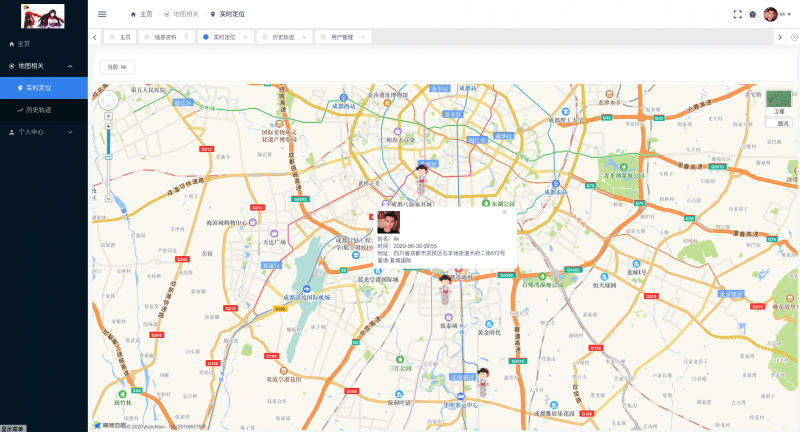
实时定位功能主要逻辑为:
1、从接口获取所有人的最新的定位信息,然后生成marker标注在地图上
2、并且给每个标注都注入个人信息,如头像、名字、时间等信息
3、可以下拉选择用户,定位到地图中心,且打开infoWindow展示个人信息
4、由于接口是没有存具体地址的,需要利用经纬度坐标,转为具体地址展示在infowindow上
详情,请参看源码。
获取接口数据,添加markers和dropdown
allNowGps() {this.getAllNowGps().then(res => {
this.data = res;
this.addMarkers(res)
this.addDropDown(res)
console.log("res", JSON.stringify(res))
})
},
addMarkers(data) {
this.infoWindow = new AMap.InfoWindow({offset: new AMap.Pixel(0, -70)});
data.forEach((item, index) => {
var marker = new AMap.Marker({
position: [item.lng, item.lat],
icon: personLogo,
offset: new AMap.Pixel(-15, -66),
map: this.map,
extData: item,
});
var info = this.getContentByItem(item);
marker.content = info.join("<br/>") //使用默认信息窗体框样式,显示信息内容
marker.on('mouseover', this.markerHover);
// marker.emit('mouseover', {target: marker});
// 真正的content的使用,是在hover打开infowindow的时候,传给indowindow进行展示的
})
this.map.setFitView();
},
addDropDown(res) {
if (res && res.length > 0) {
res.forEach(item => {
//默认获取自己的
//注意从cookie里面拿出来默认是string
if (item.uid == this.$store.state.user.userId) {
this.currentUser = item
//设为中心 显示信息
this.map.setCenter([item.lng, item.lat])
}
})
}
},
hover之后展示infowindow
markerHover(e) {var _this = this
//转换经纬度为具体地址
this.geocoder.getAddress(e.target.getPosition(), function (status, result) {
if (status === 'complete' && result.info === 'OK') {
var address = result.regeocode.formattedAddress;
console.dir(address);
const content = e.target.content + '<br/>地址:' + address;
const marker = e.target
const item = e.target.getExtData()
console.log('extData', e.target.getExtData());
_this.infoWindow.setContent(content)
_this.infoWindow.open(_this.map, e.target.getPosition());
}
});
},
这里e.target其实就是marker,然后marker的extData可以装载 item的数据,这里也取出来展示
注意,这里使用了geocoder来把经纬度坐标转为具体地址
3、历史轨迹
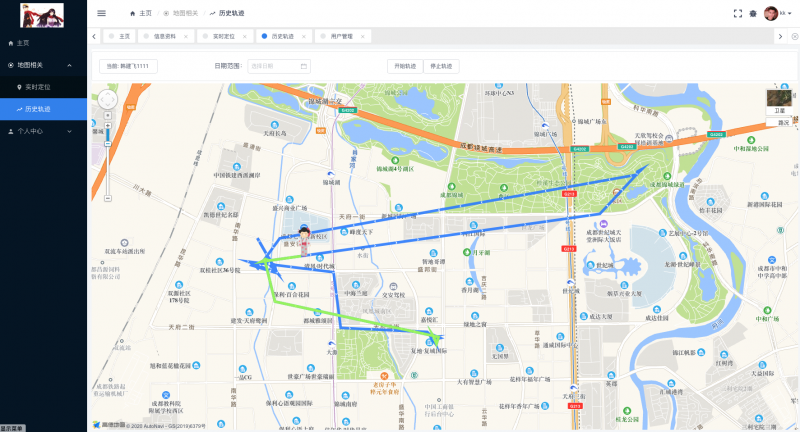
历史轨迹功能主要逻辑为:
1、默认获取当前用户的历史轨迹数据,可以通过日期筛选,并生成轨迹和marker
2、获取所有的用户,生成选择下拉列表,选择下拉,可以获取对应用户的历史轨迹数据
3、利用高德地图的绘制轨迹
4、开始marker沿着轨迹移动,模拟移动行为
allUsers() {this.handleGetAllUsers().then(res => {
console.log("users", JSON.stringify(res))
let users = [];
users = res;
this.users = users
if (res && users.length > 0) {
users.forEach(item => {
//默认获取自己的
//注意从cookie里面拿出来默认是string == 就可以比较
if (item.uid == this.$store.state.user.userId) {
this.currentUser = item
this.selectGpsHis(item.uid)
}
})
}
})
},
获取所有用户
selectGpsHis(uid, from, to) {this.getGpsHis({uid, from, to}).then(data => {
console.log("getGpsHis", JSON.stringify(data))
this.showGpsHis(data)
})
},
获取对应用户的历史轨迹数据
showGpsHis(data) {this.map.clearMap()
this.followPath = []
data.forEach((item, index) => {
const gps = [item.lng, item.lat]
this.followPath.push(gps)
})
//重组数据为 [[lng,lat],[lng2,lat2]]
if (this.followPath.length === 0) {
Message.warning('无历史数据')
return
}
this.marker = new AMap.Marker({
map: this.map,
position: this.followPath[0],
icon: personLogo,
offset: new AMap.Pixel(-15, -66),
});
// 绘制轨迹
var polyline = new AMap.Polyline({
map: this.map,
path: this.followPath,
showDir: true,
strokeColor: "#28F", //线颜色
// strokeOpacity: 1, //线透明度
strokeWeight: 6, //线宽
// strokeStyle: "solid" //线样式
});
var passedPolyline = new AMap.Polyline({
map: this.map,
// path: this.followPath,
strokeColor: "#AF5", //线颜色
// strokeOpacity: 1, //线透明度
strokeWeight: 6, //线宽
// strokeStyle: "solid" //线样式
});
this.marker.on('moving', function (e) {
passedPolyline.setPath(e.passedPath);
});
this.map.setFitView()
},
绘制轨迹并且生成marker
startAnimation() {this.marker.moveAlong(this.followPath, 5000);
},
stopAnimation() {
this.marker.stopMove()
},
开始轨迹、停止轨迹,轨迹速度是按照地图的每小时多少千米的速度来设置的。
注意:拿到的数据,需要重组成 轨迹所需的数据结构。
四、modal弹框template自定义
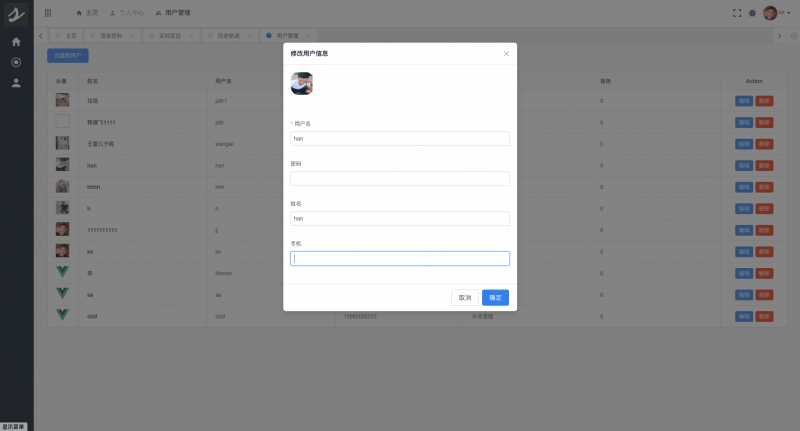
对于用户管理,我们有创建和编辑用户资料,两个格式相同,可以复用。这里自定义的modal模板,可以参考一下。
代码较长:
<template><Modal :value="isShow" :title="title" @on-visible-change="handleVisible">
<Upload
ref="upload"
:show-upload-list="false"
:on-success="handleUploadSuccess"
:format="['jpg','jpeg','png']"
:max-size="2048"
:on-format-error="handleUploadFormatError"
:on-exceeded-size="handleUploadMaxSize"
:headers="header"
type="drag"
:action="uploadUrl"
style="display: inline-block;width:50px;height:50px;margin-bottom: 50px">
<Avatar :src='https://juejin.im/post/5f114f21e51d45347c1b8fca/user.avatar'/>
</Upload>
<Form ref="user" :model="user" :rules="ruleValidate">
<FormItem label="用户名" prop="username">
<Input v-model="user.username"/>
</FormItem>
<FormItem label="密码" prop="password">
<Input v-model="user.password"/>
</FormItem>
<FormItem label="姓名">
<Input v-model="user.name"/>
</FormItem>
<FormItem label="手机" prop="mobile">
<Input v-model="user.mobile"/>
</FormItem>
</Form>
<div slot="footer">
<Button size="large" @click="handleCancel">取消</Button>
<Button type="primary" size="large" @click="handleConfirm('user')">确定</Button>
</div>
</Modal>
</template>
<script>
export default {
name: 'edit-user',
props: {
//姓名、头像、手机、用户名、密码、
user: {
uid: '',
avatar:'',
name: '',
username: '',
password:null,
mobile: '',
},
//是否显示弹框
isShow: false,
//上传所需的token
header: {},
//上传地址
uploadUrl: {},
isEdit: {
type: Boolean
},
},
computed: {
title() {
return this.isEdit === true ? "修改用户信息" : "新建用户信息"
},
ruleValidate() {
console.log('ruleValidate', this.isEdit)
const rule = this.isEdit === true ? this.editRuleValidate : this.createRuleValidate
console.log('ruleValidate', rule)
return rule
}
},
watch:{
isShow(val){
console.log('isShow',val)
}
},
data() {
return {
editRuleValidate: {
username: [
{required: true, message: 'The name cannot be empty', trigger: 'blur'}
],
mobile:[
{ required: false, message: "请输入手机号码", trigger: "blur" },
{ pattern: /^1[3456789]\d{9}$/, message: "手机号码格式不正确", trigger: "blur"}
]
},
createRuleValidate: {
username: [
{required: true, message: 'The name cannot be empty', trigger: 'blur'}
],
password: [
{required: true, message: 'The password cannot be empty', trigger: 'blur'}
],
mobile:[
{ required: false, message: "请输入手机号码", trigger: "blur" },
{ pattern: /^1[3456789]\d{9}$/, message: "手机号码格式不正确", trigger: "blur"}
]
}
}
},
methods: {
handleUploadSuccess(res, file) {
console.log(file.response)
this.user.avatar = file.response
},
handleUploadFormatError(file) {
this.$Notice.warning({
title: 'The file format is incorrect',
desc: 'File format of ' + file.name + ' is incorrect, please select jpg or png.'
});
},
handleUploadMaxSize(file) {
this.$Notice.warning({
title: 'Exceeding file size limit',
desc: 'File ' + file.name + ' is too large, no more than 2M.'
});
},
//处理确定
handleConfirm(name) {
this.$refs[name].validate((valid) => {
console.log('handleConfirm validate',valid)
if (valid) {
//发送ok事件
this.$emit('ok', {user: this.user, isEdit: this.isEdit})
//关闭弹框
this.$emit('visible', false)
}
})
},
handleCancel() {
//关闭弹框
this.$emit('visible', false)
},
handleVisible(visible) {
//每次都清空验证信息 因为编辑和创建不一样
this.$refs['user'].resetFields();
//发送事件给父组件 修改自己的visible状态(注意这里 不能用v-model数据绑定 子组件不能修改父组件传来的prop的对象状态)
this.$emit('visible', visible)
}
},
};
</script>
使用:
<div v-if="isShowEdit"><EditUser :user="newUser"
:isEdit="isEdit"
@visible="this.handleEditVisible"
:is-show="true"
:header="{'token': this.$store.state.user.token}"
:upload-url="this.$config.baseUrl + 'upload'"
@ok="handleEditOk"
></EditUser>
</div>
通过isEdit去判别是编辑还是新建
这里有一点比较重要:
isShowEdit是用于我们动态去展示和隐藏modal弹框,使用的是v-if。网上很多人,是使用modal的v-model或者value来控制modal的显示和隐藏的,原本我也是那样做的,但是后来发现,那样做非常不稳定和可靠,有时候弹框弹出来,其双向绑定的is-show,并未能和modal的状态统一。所以,最终使用的是div+v-if的方式来控制。
还有就是,关于父组件和子组件之间传值的问题:
父给子,一般是通过props来接收,并且,我们希望的是单向的,父可以改变控制子,但是,子不能改变去控制父,不然会报错。而需要使用,子发事件回调给父,来改变父的状态的方式来实现。
//处理确定handleConfirm(name) {
this.$refs[name].validate((valid) => {
console.log('handleConfirm validate',valid)
if (valid) {
//发送ok事件
this.$emit('ok', {user: this.user, isEdit: this.isEdit})
//关闭弹框
this.$emit('visible', false)
}
})
},
handleVisible(visible) {
//每次都清空验证信息 因为编辑和创建不一样
this.$refs['user'].resetFields();
//发送事件给父组件 修改自己的visible状态(注意这里 不能用v-model数据绑定 子组件不能修改父组件传来的prop的对象状态)
this.$emit('visible', visible)
}
this.$emit('visible', false) 使用这个来改变其父的isShowEdit的值,从而隐藏或者显示自身modal。
上传头像
<Uploadref="upload"
:show-upload-list="false"
:on-success="handleUploadSuccess"
:format="['jpg','jpeg','png']"
:max-size="2048"
:on-format-error="handleUploadFormatError"
:on-exceeded-size="handleUploadMaxSize"
:headers="header"
type="drag"
:action="uploadUrl"
style="display: inline-block;width:50px;height:50px;margin-bottom: 50px">
<Avatar :src='https://juejin.im/post/5f114f21e51d45347c1b8fca/user.avatar'/>
</Upload>
上传头像注意下,如果我们上传图标需要header,比如传token的话,需要把header作为参数传进来。
五、登录验证
对于登录验证,我们这边是使用vue-router的beforeEach统一处理页面的跳转来实现的。
const router = new Router({routes: routers,
mode: 'history',
})
const turnTo = (to, access, next) => {
// if (canTurnTo(to.name, access, routes)) next() // 有权限,可访问
// else next({replace: true, name: 'error_401'}) // 无权限,重定向到401页面
next()
}
router.beforeEach((to, from, next) => {
iView.LoadingBar.start()
const token = getToken()
if (!token && to.name !== LOGIN_PAGE_NAME) {
// 未登录且要跳转的页面不是登录页
next({
name: LOGIN_PAGE_NAME // 跳转到登录页
})
} else if (!token && to.name === LOGIN_PAGE_NAME) {
// 未登陆且要跳转的页面是登录页
next() // 跳转
} else if (token && to.name === LOGIN_PAGE_NAME) {
// 已登录且要跳转的页面是登录页
next({
name: homeName // 跳转到homeName页
})
} else {
//这由于暂时没有权限系统 直接 跳转即可
// if (store.state.user.hasGetInfo) {
turnTo(to, store.state.user.access, next)
// } else {
// store.dispatch('getUserInfo').then(user => {
// // 拉取用户信息,通过用户权限和跳转的页面的name来判断是否有权限访问;access必须是一个数组,如:['super_admin'] ['super_admin', 'admin']
// turnTo(to, user.access, next)
// }).catch(() => {
// setToken('')
// next({
// name: 'login'
// })
// })
// }
}
})
router.afterEach(to => {
//设置标题
setTitle(to, router.app)
//隐藏进度条
iView.LoadingBar.finish()
window.scrollTo(0, 0)
})
总结
源码很多,所以其实很多东西都在源码里面了,可能内容篇幅较长,很少有人能够完整看完,但是,写在这里只为某些时候可能遇到类似问题,有一个借鉴参考的地方即可。就如同,我自己手敲admin框架的时候,很多时候iview-amin就是我的一个可以借鉴和参考的项目,遇到有不会的或者没有思路的,就可以参考借鉴一下,这样会好很多。
整个系列,前端、移动端、后端,都有了,打通了,接下来就是要学习一下,怎么打包,部署到服务器那些东西了。
服务器呢,我打算再使用docker,学习一番docker+nginx+mysql等实现前端和后端的线上部署,具体请参看
GPS定位系统(五)——Docker
关于作者
作者是一个热爱学习、开源、分享,传播正能量,喜欢打篮球、头发还很多的程序员-。-
热烈欢迎大家关注、点赞、评论交流!
简书:www.jianshu.com/u/d234d1569…
github:github.com/fly7632785
CSDN:blog.csdn.net/fly7632785
掘金:juejin.im/user/5efd8d…
以上是 GPS定位系统(四)——Vue前端 的全部内容, 来源链接: utcz.com/a/33430.html

